Timber Losses during Harvesting in Managed Shorea robusta Forests of Nepal
Abstract
1. Introduction
2. Materials and Methods
2.1. Studied Species
2.2. Study Area
2.3. Data Collection
2.3.1. Measurements at Felling Sites
2.3.2. Measurements at Sawmills
2.3.3. Questionnaire Survey
2.4. Data Analysis
2.4.1. Comparison: Estimated Standing Volume, Felled Volume, and Log Volume
2.4.2. Quantification of Losses in Different Stages of Harvesting
3. Results
3.1. Growth Parameters and Estimated Volume
3.2. Difference between Standing Tree Volume, Felled Tree Volume, and Log Volume
3.3. Difference between Felled Log Volume and Utilized Timber Volume
3.4. Timber Loss Reduction Strategies
3.4.1. Causes of Timber Loss
3.4.2. Timber Losses Reduction Strategies
4. Discussion
4.1. Differences on Standing Tree Volume, Felled Tree Volume, and Log Volume
4.2. Differences on Felled Log Volume and Outturn Volume
4.3. Timber Loss Reduction Strategies
5. Final Remarks and Recommendations
Author Contributions
Funding
Institutional Review Board Statement
Informed Consent Statement
Data Availability Statement
Acknowledgments
Conflicts of Interest
References
- Putz, F. Approaches to Sustainable Forest Management working paper no. 4. Cent. Int. For. Res. 1994, 62, 4. Available online: http://dlc.dlib.indiana.edu/dlc/bitstream/handle/10535/3695/WP-04n.pdf?sequence=1 (accessed on 21 March 2021).
- Behjou, F.K.; Ramezani, M.; Esfahan, E.Z.; Eftekhari, A. Wood waste during full-length and cut-to-length harvesting systems in caspian forests. Int. J. Adv. Appl. Sci. 2016, 3, 52–56. [Google Scholar] [CrossRef]
- Malik, J.; Hopewell, G.P. Sawing Recovery of Several Sawmills in Jepara. J. Penelit. Has. Hutan 2011, 29, 331–342. [Google Scholar] [CrossRef]
- McKeever, D.B. Inventories of Woody Residues and Solid Wood Waste in the United States, 2002. In Proceedings of the Ninth International Conference on Inorganic-Bonded Composite Materials Conference, Vancouver, BC, Canada, 10–13 October 2004; pp. 1–12. Available online: http://www.fpl.fs.fed.us/documnts/pdf2004/fpl_2004_mckeever002.pdf (accessed on 2 March 2021).
- Asner, G.P.; Keller, M.; Lentini, M.; Merry, F.; Souza, C. Selective logging and its relation to deforestation. Geophys. Monogr. Ser. 2009, 186, 25–42. [Google Scholar] [CrossRef]
- Sofuoǧlu, S.D.; Kurtoǧlu, A. A survey for determination of wastage rates at massive wood materials processing. Wood Res. 2012, 57, 297–308. [Google Scholar]
- Koopmans, A.; Koppejan, J. Agricultural and forest residues-generation, utilization and availability. Reg. Consult. Mod. Appl. Biomass Energy 1997, 6, 10. [Google Scholar]
- Butarbutar, T.; Kohl, M.; Neupane, P.R. Harvested wood products and REDD+: Looking beyond the forest border. Carbon Balance Manag. 2016, 11, 1. [Google Scholar] [CrossRef][Green Version]
- Boltz, F.; Holmes, T.P.; Carter, D.R. Economic and environmental impacts of conventional and reduced-impact logging in Tropical South America: A comparative review. For. Policy Econ. 2003, 5, 69–81. [Google Scholar] [CrossRef]
- Pinard, M.A.; Putz, F.E. Retaining forest biomass by reducing logging damage. Biotropica 1996, 28, 278–295. [Google Scholar] [CrossRef]
- Putz, F.; Sist, P.; Fredericksen, T.; Dykstra, D. Reduced-impact logging: Challenges and opportunities. For. Ecol. Manag. 2008, 256, 1427–1433. [Google Scholar] [CrossRef]
- Johns, J.S.; Barreto, P.; Uhl, C. Logging damage during planned and unplanned logging operations in the eastern Amazon. For. Ecol. Manag. 1996, 89, 59–77. [Google Scholar] [CrossRef]
- Poudyal, B.H.; Maraseni, T.; Cockfield, G. Scientific Forest Management Practice in Nepal: Critical Reflections from Stakeholders’ Perspectives. Forests 2019, 11, 27. [Google Scholar] [CrossRef]
- MSFP. Private Sector Involvement and Investment in Nepal’s Forestry: Status, Prospects and Ways Forward. 2014, p. 170. Available online: https://3c5.com/ckhpU (accessed on 8 May 2021).
- Dipak, D.B.; Jayasawal, D. Scientific Forest Management Initiatives in Nepal: MSFP Experiences and Lessons Learnt. Kathmandu Multi Stakehold. For. Progr. Nepal. 2016, 1–44. Available online: https://3c5.com/bMrAp (accessed on 21 April 2021).
- DoFSC. Hamro Ban Nepal. In Annual Report of Department of Forest and Soil Conservation Nepal; DoFSC: Kathmandu, Nepal, 2020; p. 49. [Google Scholar]
- DoC. Department of Customs. Foreign Trade Statistics FY2075/76 (2018/19), Govt. of Nepal, Kathmandu. 2020. Available online: https://www.customs.gov.np/en/monthlystatstics.html (accessed on 20 June 2020).
- Subedi, V.R.; Bhatta, K.D.; Poudel, I.P.; Bhattarai, P. Application of silvicultural system, yield regulation and thinning practices in natural forests: Case study from western Terai. Banko Janakari 2018, 27, 92–97. [Google Scholar] [CrossRef]
- Nuberg, I.K.; Shrestha, K.; Bartlett, A.G. Pathways to forest wealth in Nepal. Aust. For. 2019, 82, 106–120. [Google Scholar] [CrossRef]
- GoN/MoFSc. Nepal National Biodivesity Strategy and Action Plan: 2014–2020. 2014, p. 226. Available online: https://www.cbd.int/doc/world/np/np-nbsap-v2-en.pdf (accessed on 8 April 2021).
- Yadav, B.K. Reflection and Perspectives of timber harvesting in Nepal. 2003, pp. 1–9. Available online: https://www.rinya.maff.go.jp/code-h2003/PART_4/Braj_K_Yadav_(Nepal).pdf (accessed on 9 May 2021).
- Köhl, M.; Magnussen, S.; Marchetti, M. Sampling Methods, Remote Sensing and GIS Multiresource Forest Inventory; Springer: Berlin/Heidelberg, Germany, 2006; ISBN 9783540325710 3540325719. [Google Scholar]
- Kanel, K.R.; Tuladhar, A.R. The Demand and Supply of Wood Products in Different Regions of Nepal; Nepal Foresters’ Association: Kathmandu, Nepal, 2012; Available online: https://3c5.com/ysLbZ (accessed on 9 May 2021).
- Lock, P.; Whittle, L. Future Opportunities for Using Forest and Sawmill Residues in Australia; ABARES Project 43559; ABARES: Canberra, Australia, November 2018; ISBN 978-1-74323-398-6. ISSN 1447-8358. [Google Scholar]
- Webb, E.L.; Sah, R.N. Structure and diversity of natural and managed sal (Shorea robusta Gaertn.f.) forest in the Terai of Nepal. For. Ecol. Manag. 2003, 176, 337–353. [Google Scholar] [CrossRef]
- DFRS/FRA. Terai Forests of Nepal, no. April. 2014. Available online: http://frtc.gov.np/downloadfile/The-TeraiForestsofNepal_1579845265.pdf (accessed on 1 May 2021).
- Lamichhane, P. Carbon Sequestration Potential of Forest in Terai Region of Nepal an Economic Valuation. Master’s Thesis, University of Greifswald, Greifswald, Germany.
- Thapa, B. Natural Regeneration Potential and Tree Diversity in Shorea Robusta Forest (Shorea Robusta) under Different Management. Master’s Thesis, University of Greifswald, Greifswald, Germany, 2018. [Google Scholar]
- Walker, S.M.; Pearson, T.; Casarim, F.M. Standard Operating Procedures for Terrestrial Carbon Measurement. 2018, p. 42. Available online: https://3c5.com/YcpvX (accessed on 13 April 2021).
- Picard, N.; Gourlet-Fleury, S.; Forni, É. Estimating damage from selective logging and implications for tropical forest management. Can. J. For. Res. 2012, 42, 605–613. [Google Scholar] [CrossRef]
- Li, C.; Barclay, H.J.; Hans, H.; Sidders, D.M. Estimation of Log Volumes: A Comparative Study. 2015. Available online: https://cfs.nrcan.gc.ca/pubwarehouse/pdfs/36459.pdf (accessed on 18 May 2021).
- Mayaka, T.B.; Eba’A-Atyi, R.; Nkie, M.-C. On volume recovery index and implications for sustainable logging in Congo Basin. For. Ecol. Manag. 2014, 313, 292–299. [Google Scholar] [CrossRef]
- Sharma, T.; Pukkala, T.E. Volume equations and biomass prediction of forest trees in Nepal (Book, 1990) [WorldCat.org]. [Kathmandu]. For. Surv. Stat. Div. 1990. Available online: https://3c5.com/fUzMS (accessed on 25 May 2021).
- Poudyal, B.H.; Maraseni, T.N.; Cockfield, G. Implications of Selective Harvesting of Natural Forests for Forest Product Recovery and Forest Carbon Emissions: Cases from Tarai Nepal and Queensland Australia. Forests 2019, 10, 693. [Google Scholar] [CrossRef]
- Meilby, H.; Smith-Hall, C.; Byg, A.; Larsen, H.O.; Nielsen. J.; Puri, L.; Rayamajhi, S. Are Forest Incomes Sustainable? Firewood and Timber Extraction and Productivity in Community Managed Forests in Nepal. World Dev. 2014, 64, S113–S124. [Google Scholar] [CrossRef]
- Carlson, B.B.S.; Koerner, S.E.; Medjibe, V.P.; White, L.J.T.; Poulsen, J.R. Global Change. Biology 2017, 23, 1648–1660. [Google Scholar] [CrossRef]
- Eshun, A.A. Logglng Residue from the Tropical High Forests in the Western Region of Ghana. Ph.D. Thesis, University of Ghana, Accra, Ghana, 2000; p. 174. [Google Scholar]
- Lasco, R.D.; MacDicken, G.; Pulhin, F.; Guillermo, I.Q.; Shorea robusta es R., F.; Cruz, R.V.O. Carbon stocks assessment of a selectively logged dipterocarp forest and wood processing mill in the Philippines. J. Trop. For. Sci. 2006, 18, 212–221. [Google Scholar]
- Numazawa, C.T.D.; Numazawa, S.; Pacca, S.; John, V.M. Logging residues and CO 2 of Brazilian Amazon timber: Two case studies of forest harvesting. Resour. Conserv. Recycl. 2017, 122, 280–285. [Google Scholar] [CrossRef]
- Pulkki, R.E. Availability of Literature Synthesis on Logging Impacts in Moist Tropical Forests; Global fibre supply study: Working paper series. 1997. Available online: https://www.fao.org/3/W8270E/W8270E.pdf (accessed on 24 April 2021).
- Enters, T. Trash or Treasure? Logging and Mill Residues in Asia and the Pacific; FAO: Bangkok, Thailand, 2001. [Google Scholar]
- Olufemi, B.; Akindeni, J.O.; Olaniran, S.O. Iskorištenje drvne sirovine u promatranim pilanama područja Akure u Nigeriji. Drv. Ind. 2012, 63, 15–18. [Google Scholar] [CrossRef]
- Eroǧlu, H.; Özkaya, M.S.; Acar, H.H.; Karaman, A.; Yolasigmaz, H.A. An investigation on roundwood extraction of fagus orientalis lipsky abies nordmanniana stew. spach and picea orientalis l. link by urus m III forest skyline on snow. Afr. J. Biotechnol. 2009, 8, 1082–1089. [Google Scholar] [CrossRef]
- Vanderberg, M.R.; Wang, J.; Mcneel, J.; Dean, D. Harvested Log Damage and Value Loss Associated With Two Ground-Based Har Vesting Systems in Central Appalachia. 2002. Available online: https://3c5.com/ahFNj (accessed on 23 March 2021).
- Louman, B. The Use of Small Portable Sawmills in Forest Management in Papua New Guinea. 1996, p. 10. Available online: http://www.odi.org.uk/sites/odi.org.uk/files/odi-assets/publications-opinion-files/1120.pdf (accessed on 28 April 2021).
- Dykstra, D.P.; Heinrich, R. FAO Model Code of Forest Harvesting Practice. 1996. Available online: https://www.fao.org/3/v6530e/v6530e00.htm (accessed on 21 May 2021).
- Bembenek, M.; Giefing, D.F.; Karaszewski, Z.; Mederski, P.S.; Szczepańska, A. Uszkodzenia drzew w nizinnych drzewostanach Świerkowych podczas zabieǵu trzebieży późnej. Sylwan 2013, 157, 892–898. [Google Scholar]
- Ghaffarian, M.R.; Sobhani, H. Optimization of an existing forest road network using Network 2000. Croat. J. For. Eng. 2007, 28, 185–193. [Google Scholar]
- Rivett, S.L.; Bicknell, J.E.; Davies, Z.G. Effect of reduced-impact logging on seedling recruitment in a neotropical forest. For. Ecol. Manag. 2016, 367, 71–79. [Google Scholar] [CrossRef]
- Pickens, J.B.; Lee, A.; Lyon, G.W. Optimal bucking of northern hardwoods. North. J. Appl. For. 1992, 9, 149–152. [Google Scholar] [CrossRef]
- Hendrison, J. Damage-Controlled Logging in Managed Tropical Rain Forest in Suriname; Hendrison, 1990; Available online: https://library.wur.nl/WebQuery/wurpubs/11907 (accessed on 23 April 2021).
- Bertault, J.-G.; Sist, P. An experimental comparison of different harvesting intensities with reduced-impact and conventional logging in East Kalimantan, Indonesia. For. Ecol. Manag. 1997, 94, 209–218. [Google Scholar] [CrossRef]
- Sist, P. Reduced-impact logging in the tropics: Objectives, principles and impacts. Int. For. Rev. 2000, 2, 3–10. [Google Scholar]
- Pinard, M.A.; Putz, F.E.; Tay, J.; Sullivan, T.E. Creating timber harvest guidelines for a Reduced-Impact Logging Project in Malaysia. J. For. 1995, 6, 41–45. [Google Scholar]
- Sargent, C.; Burgess, P. The "Wokabout Somil." Some Issues in Small-Scale Sawmilling in Papua New Guinea. 1988. Available online: https://agris.fao.org/agris-search/search.do?recordID=XF2015039122 (accessed on 20 May 2021).
- Smorfitt, D.B.; Herbohn, J.L.; Harrison, S. Factors in the acquisition and utlisation of portable sawmills in Queensland. Aust. For. 1999, 62, 45–50. [Google Scholar] [CrossRef]
- Bostrand, L. Introduction to Ergonomics in Forestry in Developing Countries; FAO: Rome, Italy, 1992; Available online: https://www.fao.org/3/ap419e/ap419e00.pdf (accessed on 12 May 2021).
- Putz, F.E.; Dykstra, D.P.; Heinrich, R. Why Poor Logging Practices Persist in the Tropics. Conserv. Biol. 2000, 14, 951–956. [Google Scholar] [CrossRef]
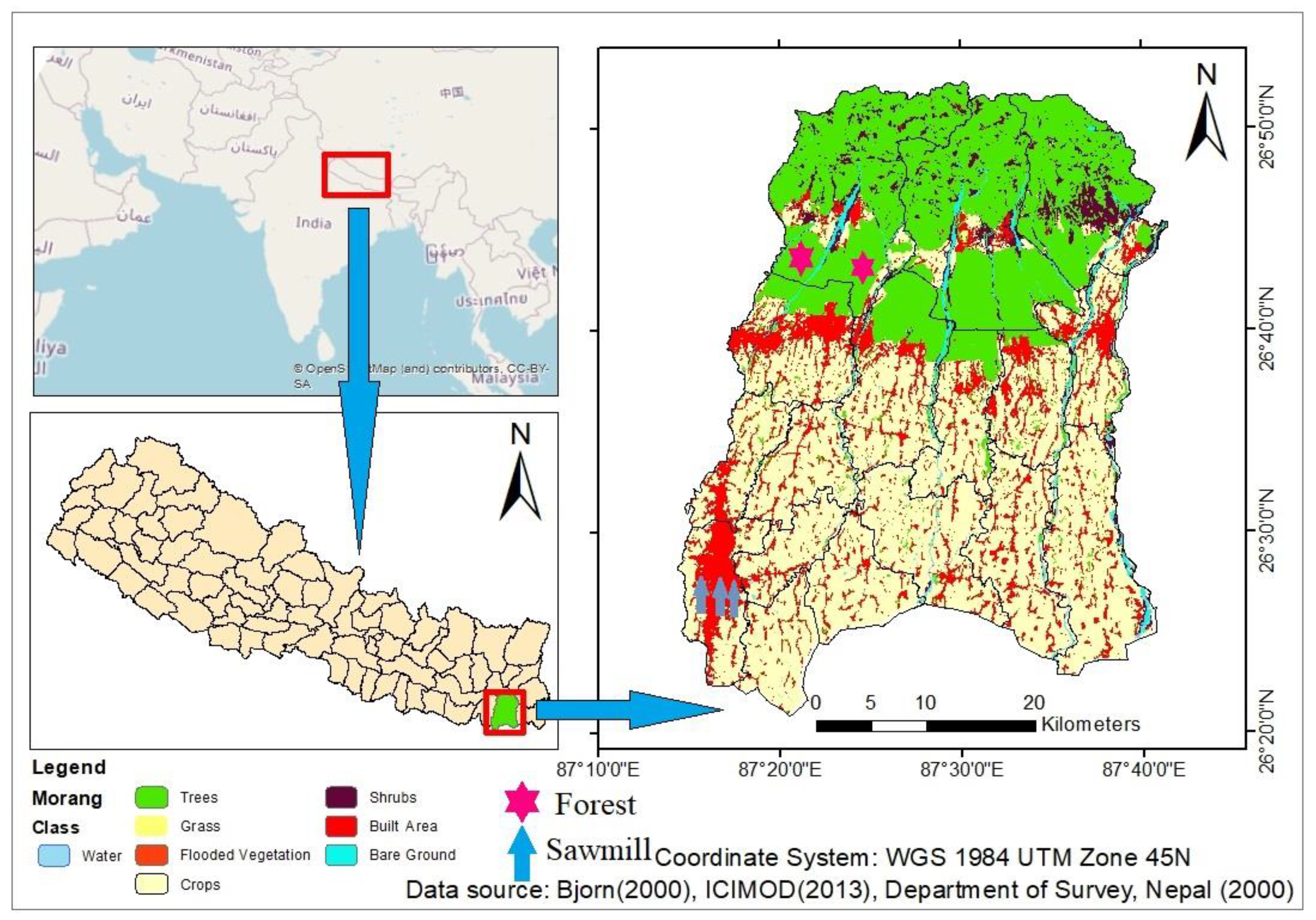
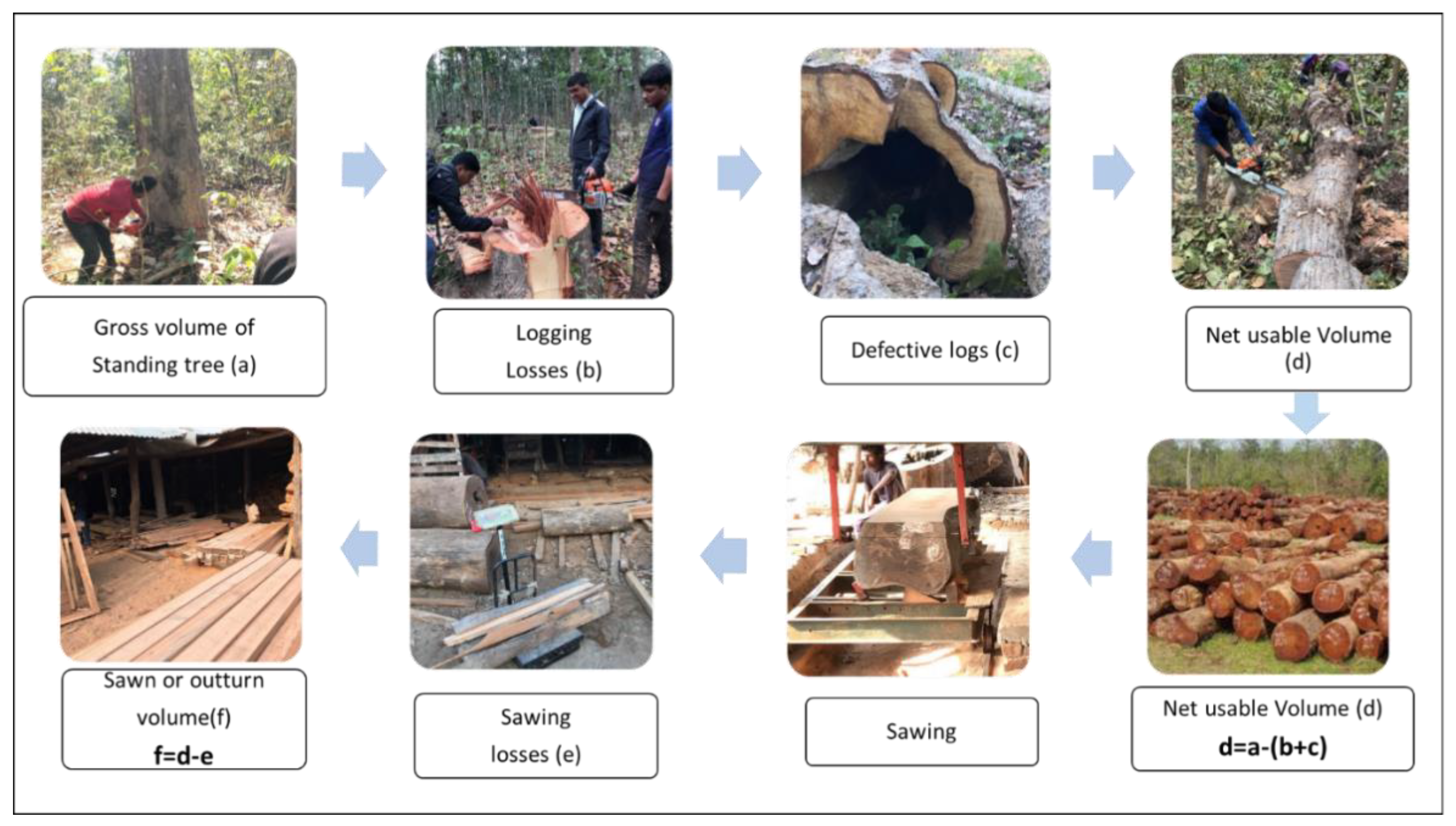

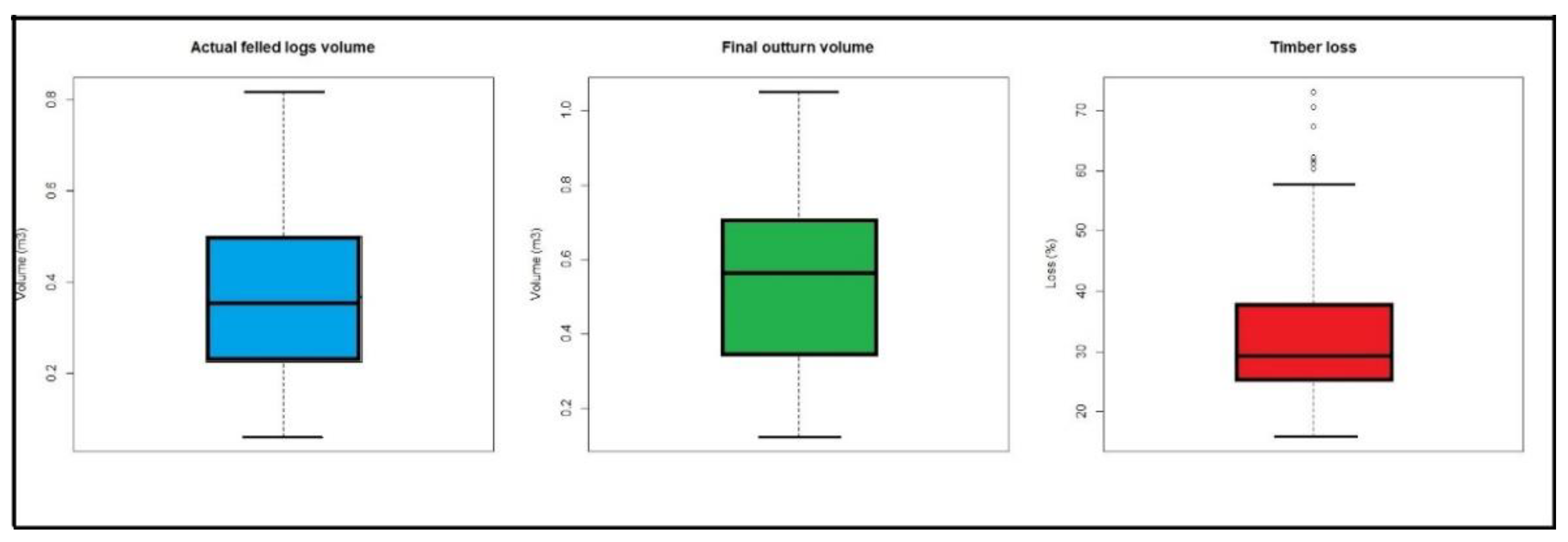
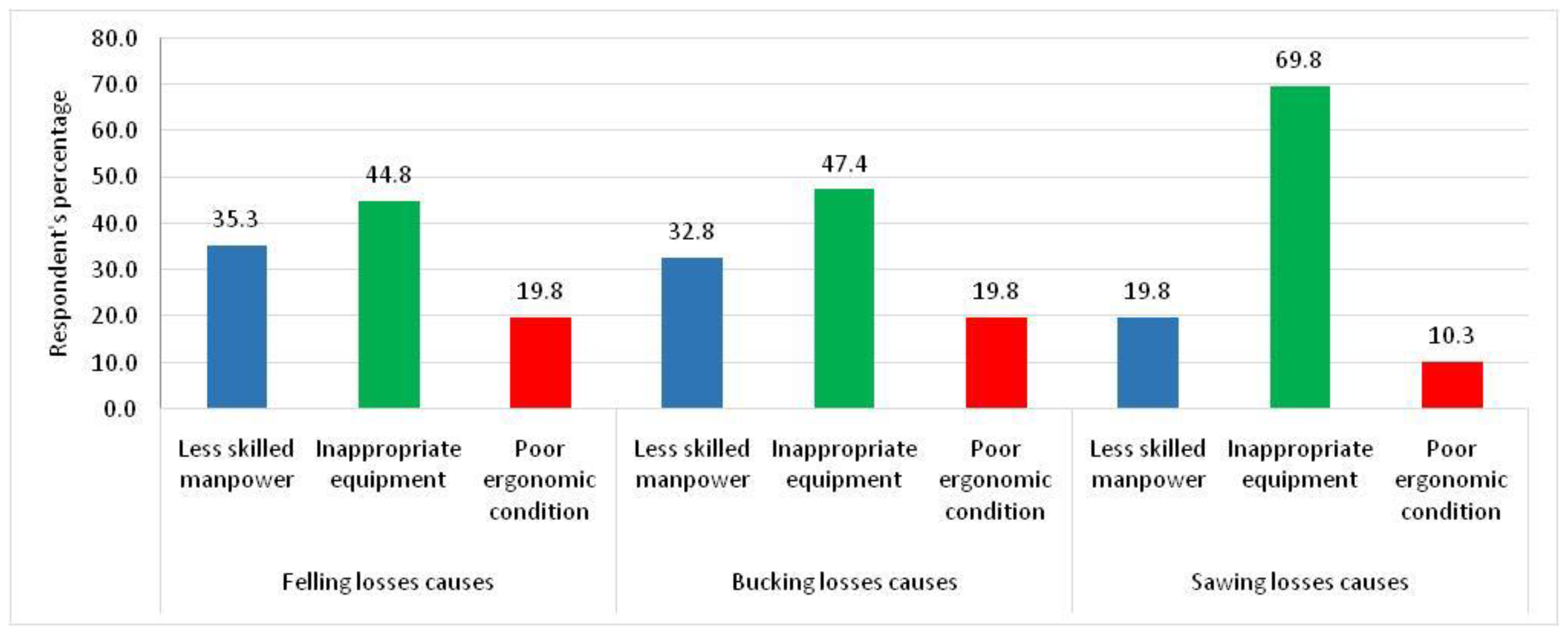
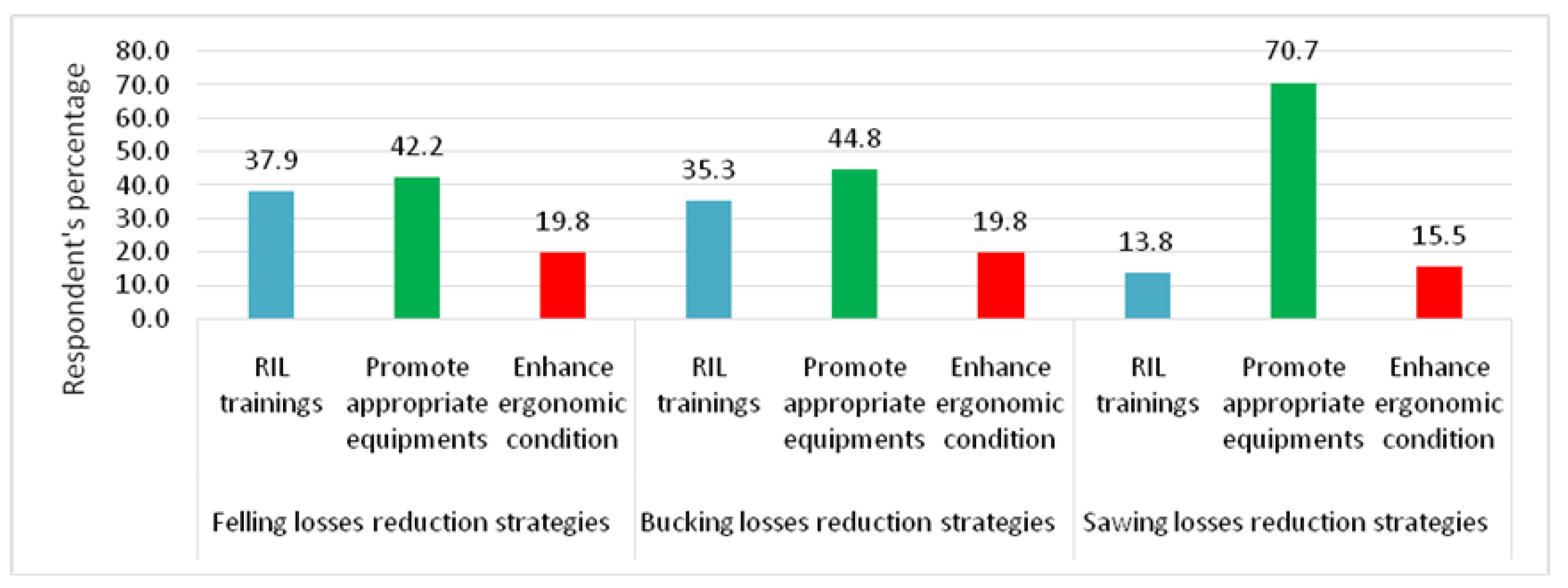
| S.N. | Estimates | Model Used | Description of Notations |
|---|---|---|---|
| 1. | Standing and felled tree volume | Ln(V) = a + bLn (d) + cLn (h) Where a = −2.4554, b = 1.9026, and c = 0.8352 (Sharma and Pukkala, 1990) [33] | Ln = natural log base; V = volume in m3; d = diameter at breast height in cm; h = total tree height in m; a, b, and c are coefficients of species. Note: values were divided by 1000 to convert them to m3 |
| 2. | Stump volume | Vs =𝜋d2× h/4 | Vs = stump volume in m3, d = mid-height diameter of the stump in m, and h = stump height in m |
| 3. | Stem rot and sawn planks volume | V = l × b × h | V = volume in m3, l = length in m, b = breadth in m, and h = height in m |
| 4. | Log volume | V = (S1+ 4 Sm +S2) × L/6(Newton’s formula) | V = log volume in m3, S1 = upper-end basal area in m2, Sm = middle basal area in m2, S2 = lower-end basal area in m2, L = length of the log in m, and basal area (S) = πd2/4 in m2 |
| Type | No. | DBH/dm (cm) * | Height/Length (m) ** | Total Estimated Volume (m3) *** | ||||||||
|---|---|---|---|---|---|---|---|---|---|---|---|---|
| Mean | Min | Max | S.D. (σ) | S.E. | Mean | Min | Max | S.D. (σ) | S.E. | |||
| Tree | 51 | 72.9 | 47 | 96 | 12.29 | 1.72 | 30.78 | 15.20 | 48.90 | 5.84 | 0.82 | 299.11 |
| Log | 167 | 57 | 32 | 79 | 0.11 | 0.01 | 1.99 | 1.52 | 2.74 | 0.27 | 0.02 | 89.98 |
| Estimated Standing Tree Volume (m3) | Actual Felled Tree Volume (m3) | Bucked Logs Volume (m3) | Bucked Logs Volume after Deducting Stem Rot (m3) | Timber Loss (%) | Timber Loss after Deducting Stem Rot (%) |
|---|---|---|---|---|---|
| (a) | (b) | (c) | (d) | (e) = ((b − c)/b) × 100 | (f) = ((b − d)/b) × 100 |
| 299.1 | 277.11 | 217.29 | 212.3 | 21.59 | 23.38 |
| Total Log Volume (m3) | Log Volume after Deducting Stem Rot (m3) | Final Outturn Volume (m3) | Stem Rot Volume (m3) | Timber Loss (%) | Timber Loss after Deducting Stem Rot (%) |
|---|---|---|---|---|---|
| (a) | (b) | (c) | d = (a − b) | e = (a − c)/a) × 100 | f = (b − c)/b) × 100? |
| 89.98 | 88.59 | 62.26 | 1.39 | 30.81 | 29.72 |
| Study Area | Loss Rate | Authors |
|---|---|---|
| Nepal | 19.8% (left over) | [34] |
| Nepal | 27% | [35] |
| Gabon | 25% | [36] |
| Ghana | 30% | [37] |
| Latin America | 44% | Dykstra and Heinrich [34] * |
| Africa | 46% | Dykstra and Heinrich [34] * |
| Sarawak Malaysia | 46% | Noack [34] * |
| Australia | 47.20% | [34] |
| Asia | 50% (1:1 ratio) | [8] |
| Tropical region (avg.) | 50% | Dykstra and Heinrich [34] * |
| Asia–Pacific | 54% | Dykstra and Heinrich [34] * |
| The Philippines | 60% | [38] |
| Brazilian Amazon | 66% (1:2 ratio) | [39] |
| Terai Shorea robusta forest, Nepal | 21.59% | This study |
| 23.58% (after deducting stem rot) |
| Study Area | Loss Rate | References |
|---|---|---|
| Indonesia | 20–30% | [3] |
| Nepal | 39% | [34] |
| China | 40% | Chen [40,41] * |
| Nigeria | 43.92% | [42] |
| Malaysia | 45% | Poyry [40,41] * |
| Indonesia | 46% | Gintings and Roliadi [40,41] * |
| Malaysia | 48% | Rayn [40,41] * |
| Many developing countries | 49.20 (40–58)% | [41] |
| Asia–Pacific | 50% | Dykstra and Heinrich [40,41] * |
| Southeast Asia | 50% | IUFRO [40,41] * |
| Papua New Guinea | 50% | FAO [40,41]* |
| Malaysia | 50–58% | [7] |
| Terai Shorea robusta forest, Nepal | 30.81% | This study |
| 29.72% (after deducting stem rot) |
Publisher’s Note: MDPI stays neutral with regard to jurisdictional claims in published maps and institutional affiliations. |
© 2022 by the authors. Licensee MDPI, Basel, Switzerland. This article is an open access article distributed under the terms and conditions of the Creative Commons Attribution (CC BY) license (https://creativecommons.org/licenses/by/4.0/).
Share and Cite
Aryal, U.; Neupane, P.R.; Rijal, B.; Manthey, M. Timber Losses during Harvesting in Managed Shorea robusta Forests of Nepal. Land 2022, 11, 67. https://doi.org/10.3390/land11010067
Aryal U, Neupane PR, Rijal B, Manthey M. Timber Losses during Harvesting in Managed Shorea robusta Forests of Nepal. Land. 2022; 11(1):67. https://doi.org/10.3390/land11010067
Chicago/Turabian StyleAryal, Upendra, Prem Raj Neupane, Bhawana Rijal, and Michael Manthey. 2022. "Timber Losses during Harvesting in Managed Shorea robusta Forests of Nepal" Land 11, no. 1: 67. https://doi.org/10.3390/land11010067
APA StyleAryal, U., Neupane, P. R., Rijal, B., & Manthey, M. (2022). Timber Losses during Harvesting in Managed Shorea robusta Forests of Nepal. Land, 11(1), 67. https://doi.org/10.3390/land11010067







